Kadoorie Synagogue
| Kadoorie Mekor Haim Synagogue | |
|---|---|
| Sinagoga Mekor Haim Sinagoga | |
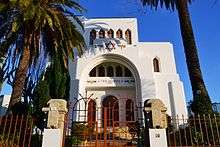 The front facade of the synagogue as seen along the Rua Guerra Junqueiro | |
| Basic information | |
| Location | Guerra Junqueiro street, Lordelo do Ouro e Massarelos, Porto, Portugal |
| Geographic coordinates | 41°9′21.38″N 8°38′12.9″W / 41.1559389°N 8.636917°W |
| Affiliation | Orthodox Judaism |
| Rite | Sephardic |
| Administration | Instituto Gestão do Patrimonio Arquitectónico e Arqueológico |
| Status | Active |
| Website | http://comunidade-israelita-porto.org |
| Architectural description | |
| Architect(s) | Augusto dos Santos Malta, Arthur de Almeida Jr. |
| Architectural style | Modern |
| Founder | Artur Barros Basto |
| Groundbreaking | 1929 |
| Completed | 1938 |
| Specifications | |
| Capacity | 350+ |
| Materials | Azulejo, wood, concrete |
The Kadoorie Mekor Haim Synagogue (Portuguese: Sinagoga do Porto/Sinagoga Kadoorie Mekor Haim/Museu Judaico do Porto) is a synagogue of the Jewish community of Porto, situated in the civil parish of Lordelo do Ouro e Massarelos, the municipality of Porto, in the Portuguese northern district of Porto. Constructed along the Rua Guerra Junqueiro in 1929, and inaugurated in 1938, it is the largest synagogue in the Iberian Peninsula and Southwestern Europe.
History
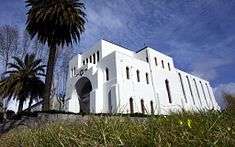

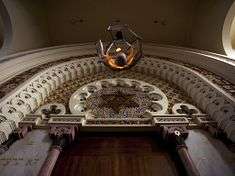
The foundation of the synagogue dates to 1923, with the initiatives of the Jewish community in Porto, and Captain Artur Barros Basto a Sephardic Ben Anusim returnee to Judaism.[1] Generally, three organized Jewish communities had existed in Portugal: in Lisbon, Porto and Belmonte; there are 6000 people that express themselves as Jewish.[1] Captain Barros Basto was one of the most important figures in the community, linked to the founding and an organized Jewish movement in the northern community.[1] There were at least twenty Ashkenazim Jews in the city; since there was no synagogue they needed to travel to Lisbon, for all their religious matters.
After realizing the need for a synagogue and under his own initiative, Barros Basto began to plan a synagogue, officially registering the local Jewish community with the local government in 1923, the Comunidade Israelita do Porto (Israelite Community of Porto).[1] During this time, the membership occupied a house on the Rua Elias Garcia. In 1927, Barros Basto founded the Portuguese Jewish Newspaper Ha-Lapid.
Barro Bastos was able to raise funds to buy a plot of land for the community.[1] On 13 November 1929 an application for the necessary licensing to begin work was delivered to the municipal council and, a few weeks later, the first stone was laid and construction begun.[1] Construction on the site began in 1929, a project of architects Artur de Almeida Júnior and Augusto dos Santos Malta (an architect trained in the Escola das Belas Artes de Porto), in collaboration with Rogério de Azevedo, in the interior.[1] The master Rogério de Azevedo, may also have had directly involved in the work, with the some finishes (including woodwork in the library), completed in a style characteristic of Rogério de Azevedo's works.[2]
Between 1930 and 1935, the Israeli Technology Institute was installed in the building, even before its conclusion.[1] The work progressed slowly until 1933, despite support from the Committee for Spanish-Portuguese Jews in London.[1] In 1937, the synagogue was concluded, thanks to the contributions from the Jewish community in London and from funds donated by the Kadoorie family and Iraqi Jews from Portugal.[1] Laura Kadoorie, the wife of a prominent Jewish philanthropist from Iraqi, Sir Elly Kadoorie died, and her children saw the need to honor their mother (a descendant who had fled the country following the Inquisition). This tribute was reflected in the monetary support by the Kadoorie family, to assist in the construction of large part of the synagogue in Porto, which was later renamed Synagogue Kadoorie - Mekor Haim.[1] In the same year, Captain Artur Barros Basto was expelled from the Portuguese army for his participation in circumcisions.[1] The synagogue was inaugurated in 1938.[1]
During the Second World War, hundreds of refugees passed through the doors of the synagogue en route to the United States.[1]
Former Captain Barros Bastos died in 1961.[1]
In 2012, the synagogue was open to the public.[1]
Experts from the Israeli governmental agency visited in 2014, and approved co-financing for renovations and security upgrades for the synagogue.[1] On 21 May 2015, the Jewish Museum of Porto was open to the public, and was inaugurated on 28 June, with the presence of the president of the CIP Comunidade Israelita do Porto (Porto Israeli Community) and various cultural, education and political personalities.[1] A fence was erected along the lateral facades and rear of the building.[1]
The community counts, among its members, Jews of various origins such as Poland, Egypt, the United States, India, Russia, Israel, Spain, Portugal and England. The present rabbi, Daniel Litvak (a native of Argentina), guides the community, with its current vice president, the granddaughter of Captain Barros Basto, Isabel Ferreira Lopes.
Architecture
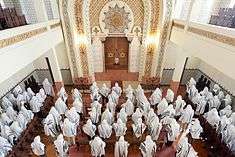
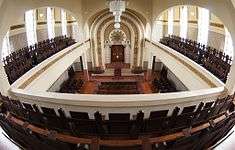
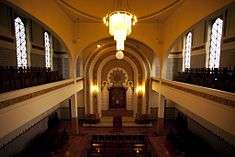
The building is in an urban context, on an elevated platform encircled by fencing between Rua Guerra Junqueiro and Rua João Martins Branco, in an area of residential homes of Campo Alegre.[1] To the north is a barrio, while to the rear is a small parking lot and the Clube de Ténis do Porto (Porto Tennis Club).[1] In the proximity of the rear wall is the Cemitério de Agra Monte (Agra Monte Cemetery) along Rua João Martins Branco.[1]
The temple consists of rectangular structure oriented west to east, covered in differentiated roof tile.[1] Over the entranceway and services is a cupola. The principal facade, oriented to the west, is marked by a galilee with a large arch, where the main portico is inserted in a recess.[1] In the centre is a varanda with inscriptions and glazed colonnade, while over the bow of the galilee, is the Jewish star.[1]
The lateral facades, to the north and south, are characterized by the volumes of each body, and by a regular rhythmic distribution of very elongated triangular-topped windows.[1] The rear facade, blind and symmetrical, consists of a plane from which three protruding volumes of flat roof stand out.[1]
The interior is marked by an entrance space, flanked by two rooms, followed by the large rectangular hall, flanked on either side by two landing steps and two accessways to further spaces.[1] The hall is the principal celebration space, with dome ceiling, contoured on the upper level by a balcony with two rows of arranged chairs.[1] The remainder of the interior is decorated with Hebrew passages from the Torah, complemented by Moroccan-Sephardic decorations.[1]
See also
External links
- Comunidade Israelita do Porto Website
- Kadoorie Synagogue, Symbol against anti-Semitism – Video
- ADL Welcomes Reinstatement of Captain Ousted from Portuguese Army Due to Anti-Semitism
- Portuguese Synagogue's 75th Anniversary: "Struggle for Freedom"
- The Synagogue of the Portuguese Dreyfus Creates a YouTube Success
- The Acoustics of the Mekor Haim Synagogue, Portugal - António P. Carvalho e José D. Amado - Laboratório de Acústica, Faculdade de Engenharia, Universidade do Porto
References
- 1 2 3 4 5 6 7 8 9 10 11 12 13 14 15 16 17 18 19 20 21 22 23 24 25 26 27 28 29 30 Sereno, Isabel (1998), Sinagoga do Porto/Sinagoga Kadoorie Mekor Haim/Museu Judaico do Porto (IPA.00005567/PT011312070213) (in Portuguese), Lisbon, Portugal: SIPA – Sistema de Informação para o Património Arquitectónico, retrieved 7 May 2017
- ↑ Elvira de Azevedo Mea and Inácio Steinhardt (1997), p.222
Bibliography
- Mandim, David (19 August 2015), "A maior Sinagoga Ibérica tem as suas portas abertas", Diário de Notícias (in Portuguese), p. 20
- Pires, Sérgio (29 January 2015), "Muro da Sinagoga do Porto já está a ser erguido com ajuda israelita", Diário de Notícias (in Portuguese), p. 29
- Quaresma, Maria Clementina de Carvalho (1995), Inventário Artístico de Portugal: cidade do Porto (in Portuguese), Lisbon, Portugal
- Queirós, Óscar (28 June 2015), "500 convidados na inauguração do Museu Judaico", Jornal de Notícias (in Portuguese), Lisbon, Portugal, p. 22
- O Público (in Portuguese), 22 January 1996
- "Entrevista com Joshua Ruah", Patrimónia, Identidade, Ciências Sociais e Fruição Cultural (in Portuguese) (3), 1 November 1997
- Mea, Elvira de Azevedo; Steinhardt, Inácio (1997), Ben-Rosh. Biografia do Capitão Barros Basto, Lisbon, Portugal